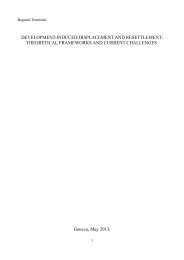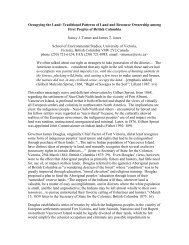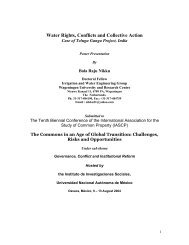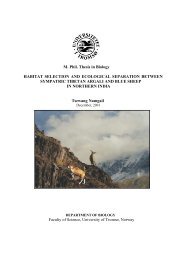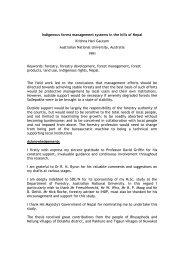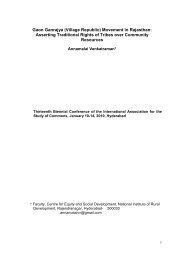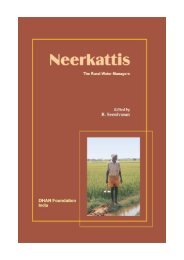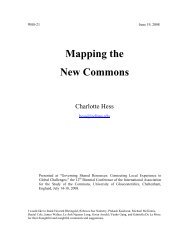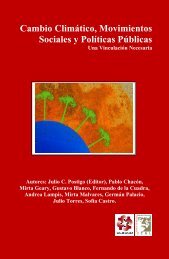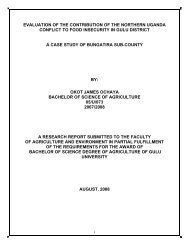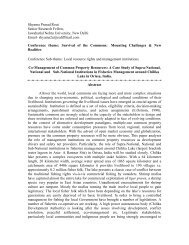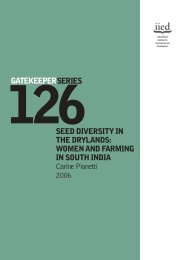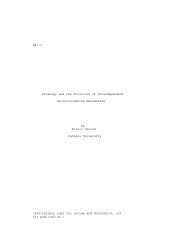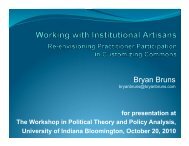Contesting Land and Identity In The Periphery: The Moro Indigenous ...
Contesting Land and Identity In The Periphery: The Moro Indigenous ...
Contesting Land and Identity In The Periphery: The Moro Indigenous ...
You also want an ePaper? Increase the reach of your titles
YUMPU automatically turns print PDFs into web optimized ePapers that Google loves.
American Governor-Generals <strong>and</strong> their colonial subalterns in the Philippinesignored the US High Court’s decision <strong>and</strong> instead, perpetrated the myth of theRegalian Doctrine. During the Commonwealth period thus, ‘although there was agrowing rhetorical commitment to l<strong>and</strong> reform…little actual redistribution of l<strong>and</strong>occurred, <strong>and</strong> tenancy actually worsened under American rule’ (Owen, cited inLynch, 1982: 20). (Further, the doctrine which has been carried over up to thepresent Constitution, provided the basis for the Philippine state to declare l<strong>and</strong>sof the “public domain” as inalienable <strong>and</strong> indisposable <strong>and</strong> to classify vast tractsof l<strong>and</strong> as forest or timber, mineral, watershed, national park, town site, militaryreservation <strong>and</strong> other such reserves for public use. Only those decreed asagricultural l<strong>and</strong>s may be alienated [1987 Constitution, art. XII, sec. 2]. Maranao<strong>Moro</strong> l<strong>and</strong>s <strong>and</strong> resources in Lanao territory have suffered miserably from thisstate policy [see Our Lake for Others?, MSPC Communications, 1978]. Aware ofthe lobby in the US government for much bigger l<strong>and</strong>holdings in Mindanao(beyond the amounts allowed for American business in the earlier public l<strong>and</strong>acts), the Commonwealth government undertook a vigorous “Filipinization”policy of indentured migration to the south, following the contours of how thewestern frontier in the United States was won (Magdalena, 1998).<strong>The</strong> new property regime in Mindanao thus became an opportunity for thecolonized north-Filipino elites to own or lease substantial l<strong>and</strong>holdings as well asa chance for the “legal” or systematic l<strong>and</strong>grabbing of traditional l<strong>and</strong>s. <strong>The</strong> longdrawn-out<strong>Moro</strong> rebellion in the region can be traced back to the “regime ofhomestead” especially in the 1950’s when the Magsaysay administrationtransferred l<strong>and</strong>-seeking north-Filipinos <strong>and</strong> peasant rebel (“Hukbalahap”)members to Mindanao where they were settled as homestead patent owners byvirtue of the public l<strong>and</strong> laws based on the Regalian doctrine, to quell theagrarian unrest in Luzon. But the uprising in the north was then “transferred” tothe south when the homestead patents of settlers <strong>and</strong> the l<strong>and</strong> use holdings ofbusiness corporations encroached on the ancestral l<strong>and</strong>s of the <strong>Moro</strong>s <strong>and</strong>Lumads (non-Muslim indigenous tribes of Mindanao). <strong>The</strong> l<strong>and</strong> conflict based onethnic claims had worsened, following the American colonial administration’srequirement of a legal l<strong>and</strong> titling system, to the more violent l<strong>and</strong> disputes in thelater decades between those who had traditionally occupied the l<strong>and</strong> withoutlegal documents <strong>and</strong> those who were able to acquire l<strong>and</strong> titles or stake l<strong>and</strong>declarations on the basis of state cadastral surveys or tax declarations (Pelzer,1948). Several l<strong>and</strong>grabbers <strong>and</strong> speculators exploited the fact that the thenBureau of <strong>L<strong>and</strong></strong>s “based priority of claim upon priority of filing instead of priority ofoccupancy” (Mastura, in Lynch, 1982:35; see also Pelzer, 1948: 142; Pendatun,1933). Many <strong>Moro</strong>s, especially the Maguindanaos, who took the cadastralsurvey as a device of imposing taxes upon them, simply ab<strong>and</strong>oned their l<strong>and</strong>s<strong>and</strong> moved to other areas which had not yet been surveyed or classified aspublic l<strong>and</strong>s. Others sold their l<strong>and</strong>s away to settlers for ridiculously smallpayments, <strong>and</strong> realizing only much later the value of the property they had lost,felt they had been cheated on l<strong>and</strong> which was rightfully theirs (Stewart, 1988:116). <strong>L<strong>and</strong></strong> disputes arising from conflicting claims based on opposingconceptions of tenure systems would endure as a major irritant in relationsamong <strong>Moro</strong>s, tribals <strong>and</strong> Christian Filipino settlers. Beyond shoving the <strong>Moro</strong>sinto the interior where most of their communities are found today, the policy of5
induced migration resulted in the Christian settlers achieving a numerical minorityin provinces where <strong>Moro</strong>s earlier predominated. Areas in which non-<strong>Moro</strong> settlerscame to predominate consequently saw the shift of political power from the <strong>Moro</strong>people to the Christian migrants culminating in the division of some provinceswhich were part of the old <strong>Moro</strong> province <strong>and</strong> the creation of new political units.Conflicts that swelled during the 1970s <strong>and</strong> the state’s assimilative policies withrespect to the <strong>Moro</strong>s <strong>and</strong> other “ethnic minorities” eventually contributed to theformation of the <strong>Moro</strong> secessionist movement clamoring for an independentIslamic state under the urging of the <strong>Moro</strong> National Liberation Front (Bucoy,1987). But riding on the <strong>Moro</strong> secessionist issue, just as it did on the “communist”threat, the Marcos government justified the declaration of martial law. Fastforward to the Martial Law regime under Marcos, several Presidential Decrees(P.D.s) were passed which were apparently directed at areas occupied by ethniccommunities. A number of these P.D.s facilitated the setting up of biginfrastructure projects such as hydroelectric plants <strong>and</strong> other energy projects,making Mindanao a catch basin for development programs in answer to theMindanao problem. <strong>The</strong> question is, in the manner these policies were carriedout, this was perceived as benefiting the “outsiders” than the communities inwhose l<strong>and</strong>s the development projects were built. <strong>The</strong> Marcos government triedin vain to contain the growing <strong>Moro</strong> nationalism by promising autonomy, as theMNLF later succeeded in forging an accord with the Philippine governmentknown as the Tripoli Agreement which allowed for <strong>Moro</strong> or Muslim autonomywithin the “integrity of the Philippine Republic.” <strong>The</strong> agreeement stipulated thearea of autonomy to embrace 13 out of the 23 provinces in Mindanao, Sulu <strong>and</strong>Palawan. However, the agreement remained unimplemented until the death ofMarcos <strong>and</strong> the ascension of Cory Aquino, as an aftermath of the 1986 EDSAUprising. Before the 13 provinces became part of the proposed territory for <strong>Moro</strong>autonomy, the government conducted a Mindanao plebiscite which resulted inonly four provinces with predominantly <strong>Moro</strong> population opting to be part of <strong>Moro</strong>autonomy.Capitalist incursions, aside from state projects, have also harmed <strong>Moro</strong> localrelations of production. <strong>The</strong> renewed drive to increase exports under thesucceeding Ramos <strong>and</strong> Estrada regimes resulting in the opening of moreplantation areas in “<strong>Moro</strong>l<strong>and</strong>” (for a planned palm oil industry in the Lanaoprovinces, for instance) <strong>and</strong> government support for crop conversion forcommercial or export production (such as asparagus in South Cotabato) havedisturbed <strong>Moro</strong> ties to ancestral l<strong>and</strong> <strong>and</strong> the people’s relations of reciprocity inthe pre-existing tenurial system, as more previously small l<strong>and</strong>holding <strong>Moro</strong> tillersare increasingly being pushed into the poor peasant <strong>and</strong> l<strong>and</strong>less farm workerclasses (AFRIM, <strong>In</strong>c., 1989).<strong>The</strong> new l<strong>and</strong> ethos has also caused internal disputes <strong>and</strong> disparities in l<strong>and</strong>ownership among the members of <strong>Moro</strong> communities. <strong>The</strong> documentary regime,which bewildered the <strong>Moro</strong> Muslims, also disturbed <strong>Moro</strong> class formations <strong>and</strong>traditional property concepts. To mention one case, during the first governmentsurvey of the 1920’s, “a great amount of l<strong>and</strong> in Jolo was directly registered inSultan Jamal-ul-Kiram’s name by persons who had rights of usufruct, notrealizing that the distinction between ultimate titular ownership <strong>and</strong> ownership of6
also various documentation in <strong>Moro</strong> Kurier, 1985-1990 for cases of affected <strong>Moro</strong>communities.). <strong>The</strong> overriding question of ancestral l<strong>and</strong> then continues to be adriving force to claims for ‘special’ l<strong>and</strong> <strong>and</strong> resource rights through positivelegislation that would grant the claimants equal tenure rights with otherheretofore dominant economic <strong>and</strong> social groups, or the dem<strong>and</strong> for separatelegal status or autonomy aimed at providing them the appropriate politicalframework to protect their vested rights over their domains. Whether suchresponses are aimed at further averting future dispossession or at restoring aprevious status of l<strong>and</strong> security or territories lost in the past, these have led toconflicts or strains in inter-group <strong>and</strong> people-state relations in the Philippinepolity, especially as there has been a slow or reluctant process of the state’srecognition of customary rights to l<strong>and</strong> <strong>and</strong> resources.At the same time, the interaction between indigenous communities whoevaded foreign conquest <strong>and</strong> the colonial majority or more westernized Filipinoscontinues to be marked oftentimes by discrimination. <strong>The</strong> prejudice towardsindigenous Filipinos <strong>and</strong> contempt of customary practices built up by centuries ofcolonial occupation, though now being challenged by both non-state <strong>and</strong>governmental organizations, nevertheless persists to reinforce state policyambivalence in the recognition of customary l<strong>and</strong> rights.Responding to pressure from indigenous communities <strong>and</strong> supportive civilsociety groups reaching a high point during the “UN Declaration of 1993 as the<strong>In</strong>ternational Year of the <strong>In</strong>digenous Peoples”, the Philippine Congress drafted anumber of bills providing for the recognition of ancestral l<strong>and</strong>s <strong>and</strong> other l<strong>and</strong>tenure rights. <strong>The</strong>se bills, one of which proposed the creation of an AncestralDomain Commission, were effectively subdued by legislators who had interestsin logging, mining, <strong>and</strong> other extractive industry sectors. Due to persistent <strong>and</strong>mounting protests however, the <strong>In</strong>digenous Peoples Rights Act (IPRA) finallycame into being in 1997. Acclaimed by some reform groups <strong>and</strong> concernedconstituents as unprecedented in the state’s legislation for social equity <strong>and</strong>resource sustainability involving the indigenous communities, the (IPRA) law hasalso drawn reproach from other groups <strong>and</strong> constituents critical of the process ofits enactment <strong>and</strong> its provisions. For instance, critical groups question the state’ssincerity in recognizing indigenous tenure rights, since other laws perceived asensuring elite <strong>and</strong> corporate interests such as the National <strong>In</strong>tegrated ProtectedAreas System Act <strong>and</strong> the Mining Act were prioritized over the pending bills thatintended to protect ancestral l<strong>and</strong> rights. Among the law’s provisions seen asbiased towards privatization <strong>and</strong> individualization of l<strong>and</strong> <strong>and</strong> resources <strong>and</strong>conceding to big capitalists <strong>and</strong> l<strong>and</strong>owners, is one that, for example, recognizes“existing vested rights” within ancestral domains (DINTEG, 1998). Thus, thePhilippine l<strong>and</strong> <strong>and</strong> resource tenure scene is also strewn with disputes arisingfrom policy conflicts regarding the determination of l<strong>and</strong> <strong>and</strong> resource use <strong>and</strong>the rights of different stakeholder-groups over these uses. Two other importantpieces of state legislation relevant to the <strong>Moro</strong>s which supposedly address thethe ancestral l<strong>and</strong> question, the Comprehensive Agrarian Reform Law [CARL] of1988 <strong>and</strong> the Organic Act for the Autonomous Region of Muslim Mindanao[ARMM] 6734, reflect these contradictions. <strong>The</strong> equivocal provisions such lawscontain allowing conflicting policy interpretations tend to facilitate the erosion,8
instead of ensure the l<strong>and</strong> tenure security of customary l<strong>and</strong>owners. <strong>The</strong>regional Organic Act,, while declaring protection of the ancestral domains ofindigenous cultural communities (ICCs) (Sec. 1, Art. XI), nonetheless providesthat “titles secured under the Torrens system <strong>and</strong> rights already vestedunder…existing laws should be respected” (Sec. 2, Art. XI) (R.A. No. 6734,1989). <strong>The</strong> CARL contains a similar provision in defining ancestral l<strong>and</strong>s (whichdefinition, unlike that in O.A. 6734, fails to protect l<strong>and</strong>s lost through forcemajeure or through “forcible usurpation”) which exempts those covered by theTorrens system (Section 9, R.A. 6657 in German, 1992: 6-7). But even ifprotection of ancestral l<strong>and</strong>s (lost through force majeure) seems guaranteed inan exemption the provision allows – “that in the autonomous regions, therespective legislatures may enact their own laws” – alternative agrarian reformlaws to be enacted in the autonomous region could not contradict existing statelaws (such as Sec. 6 of the 1987 Constitution) nor result in the latter’samendment. <strong>In</strong> the Organic Act, a major area of dissension in its enactment isthe question of territory or the problem of delineating the scope of the area toconstitute the region of autonomy. <strong>The</strong> issue ultimately stems from the <strong>Moro</strong>Muslims’ conception of an irrefutable claim to ancestral domain <strong>and</strong> prior l<strong>and</strong>use rights sanctioned by customary law. Overall thus, present state laws in thePhilippines intended to recognize <strong>and</strong> protect indigenous property regimes <strong>and</strong>tenurial systems are still inadequate. While some farmer groups have benefitedfrom existing l<strong>and</strong> tenure policies <strong>and</strong> some agrarian relations were corrected tosome extent (such as tenancy arrangements in the rice-producing areas in theCentral Luzon region), indigenous communities <strong>and</strong> poor peasants remainmarginalized, even with recent amendments in l<strong>and</strong> reform legislation whichcontinue to be enacted within a framework of property rights based on Westerncolonial legal traditions. This perspective, which still predominates Philippinestate policy on l<strong>and</strong> tenure tend to clash with the traditional tenurial systemsobserved by indigenous communities <strong>and</strong> other native tillers in relating with thel<strong>and</strong> <strong>and</strong> their environment. Moreover, national l<strong>and</strong> policy is also at variancewith some Islamic views about property in the <strong>Moro</strong> areas (Putzel, 1992: 15)beyond the limited application of the Code of Muslim Personal Laws (PresidentialDecree 1083) which is part of “the law of the l<strong>and</strong>” <strong>and</strong> recognizes the <strong>Moro</strong>s’Islamic laws of inheritance <strong>and</strong> bequest systems.A long thread of conflicts arising from the above circumstances, many ofwhich await to be successfully resolved, indicate this present crisis of l<strong>and</strong> use<strong>and</strong> resource tenure both in the upl<strong>and</strong> <strong>and</strong> in the lowl<strong>and</strong> <strong>Moro</strong> ruralcommunities especially where territorial <strong>and</strong> prior resource rights of theirindigenous occupants are rapidly undergoing the stresses of modernization <strong>and</strong>capitalist development. At the same time, this reality indicates a phase oftransition in the Philippine tenure situation in which the interaction or dynamicsbetween existing tenure patterns at variance with each other may later bebridged. More importantly, it can be said that “<strong>Moro</strong>l<strong>and</strong>” is no longer the“periphery” made dependent on policy-decisions from the center, as the <strong>Moro</strong><strong>and</strong> other Mindanao peoples continue to engage the state <strong>and</strong> national politicsis articulated to the <strong>Moro</strong> issue. Meanwhile, genuine autonomy <strong>and</strong> governancefor the Bangsamoro homel<strong>and</strong> will remain an aspiration as the governmentawaits the resumption of peace talks with another <strong>Moro</strong> group, the <strong>Moro</strong> Islamic9
Liberation Front (MILF) to tackle the unresolved issue of ancestral domain rights(Today, Sept. 21, 2003).Case Study: <strong>The</strong> Maranao <strong>Moro</strong>s<strong>The</strong> Maranao (from the word ma’ranao which literally means people residingnear the lake) constitute the largest of thirteen <strong>Moro</strong>-ethnolinguistic groups in thePhilippines. Primarily an agricultural people with rice <strong>and</strong> corn as their mainproduce supplemented by freshwater fishing, they are concentrated in theCentral Mindanao region around Lake Lanao, the Philippines’ second largestinl<strong>and</strong> lake located in Lanao del Sur province. Under the Marcos martial lawgovernment, began the construction of the Lake Lanao-Agus River HydroelectricComplex which aimed at bringing six more dams <strong>and</strong> facilities to generate theenergy supply for the entire Mindanao grid. This huge project taps the powerfulflow of the Agus river system that straddles the two provinces of Lanao. Agus I<strong>and</strong> II were installed in Lanao del Sur <strong>and</strong> the rest were built in Lanao Norte,except for Agus III which has yet to be installed (for a policy background on theproject <strong>and</strong> more technical details, see Tawagon, 1988: 12-20). Lake Lanao,from which flows the Agus river, has been the symbolic <strong>and</strong> economic core of theMaranao communities around the lake. As far back as can be remembered thatthe Maranaos have been a people, ranao - the lake – has already existed. It is toLake Lanao that the Maranaos have bound their identity as a people buildingtheir villages, towns <strong>and</strong> mosques by the lake’s shores, cultivating paddy rice onthe lake’s eastern side (known as basak in Maranao folk geography). <strong>The</strong>richness <strong>and</strong> variety of the Maranao society’s economic base is revealed as onediscovers the lake’s Western shore having a different ecology <strong>and</strong> terrain. Calledkalopa’an (dry l<strong>and</strong>) by the people, here an art <strong>and</strong> craft tradition (of loom <strong>and</strong>mat weaving <strong>and</strong> brassware making) of a sophisticated level developed(Salgado, 1989), complementing farming <strong>and</strong> other agricultural activities.Through centuries, they have adopted their daily life to the normal fluctuations ofthe water level of the lake.<strong>The</strong> village of Lumbayanague, where field work was conducted, is located inthe northwest side of the lake <strong>and</strong> the biggest of four barangays of Saguiaran. Itis bounded by the town center (Saguiaran poblacion) in the south <strong>and</strong> the Agus IIdam reservoir in the west, <strong>and</strong> since the poblacion is traversed by the nationalroad, Lumbayanague is easily accessible. Saguiaran town is six kilometersaway from Marawi City, the capital town of Lanao del Sur which is populatedmostly by Maranaos; it is 30 kilometers away from Iligan city in Lanao del Nortewhere today Christian settlers have become the majority residents. BarangayNangka, our other field work site, the neighboring town of Baloi at the border ofLanao Norte, is also easily reached by l<strong>and</strong> transport <strong>and</strong> is nearer Iligan City.Lanao being outside the typhoon belt, the climate in both upl<strong>and</strong> towns is neitherdistinctly dry nor wet compared to other regions in the Philippines. Majority of theinhabitants in both villages derive their income from farming with corn as theirmain product, <strong>and</strong> root crops such as sweet potato <strong>and</strong> cassava, <strong>and</strong> vegetablesfor selling in the local market <strong>and</strong> for home use. Upl<strong>and</strong> rice, traditionally theirmain produce, is now planted only for household consumption. Aside from10
cultivating crops, the villagers also raise farm animals like the cow for plowing thefields. Poultry is raised in individual households for home consumption.<strong>In</strong>terviews with key informants 4 in the communities of Barangay Nangka,Poblacion Saguiaran <strong>and</strong> Barangay Lumbayanague concur that these villagesfrom whose l<strong>and</strong>s were contested by the National Power Corporation for theconstruction of the Agus hydroelectric facilities were part of the four traditionalMaranao principalities (equivalent to the sultanates of other <strong>Moro</strong> ethnic groups)or the four “encampments of the lake” (pat-a-pangampong a’ ranao) staked out inearlier times by the Maranaos’ founding ancestors <strong>and</strong> ancestresses (seeMednick [1965], for a description of the overall indigenous political structure in hisnoted work on Maranao social organization; cf, Saber, 1968). As an agama(“village clan settlement”), barangay Lumbayanague for one, was traditionally thecenter of the inged (Maranao township), founded by Datu Akad, the village’sancestor, long before Saguiaran was proclaimed a town under the state localgovernment. Because the Americans allowed the <strong>Moro</strong>s to continue practicingsome of their indigenous customs <strong>and</strong> beliefs during their “<strong>Moro</strong> pacification”campaigns for as long as these did not affect the colonial government’seconomic <strong>and</strong> political interests, the formal structure of the Maranao sultanatehas been left intact. Until today, even with the superimposition of Philippinecivilian state institutions in the indigenous polity, the system of social <strong>and</strong> politicalranking <strong>and</strong> positions in the traditional Maranao authority structure has beenmaintained at least in a ritualistic or symbolic way. <strong>The</strong> influence still possessedby Maranaos of high traditional rank, although titular, <strong>and</strong> the status <strong>and</strong> respectthat the community continues to accord them explain why such positions <strong>and</strong>titles are still much sought after in the Maranao society.Presumably due to a more developed “semi-feudal” formation wrought by theprocess of Islamization in pre-colonial times, the Maranaos just like the othermajor <strong>Moro</strong> groups subscribed to conceptions of territoriality more defined thanthose of other indigenous peoples. This structured hierarchy also dictated amore elaborate system of tenurial relations that still flourish in many Maranaocommunities. Aside from maintaining a communal mosque, a clan settlement ora larger community (an inged) laid claim to territory marked by naturalboundaries which included both communal property <strong>and</strong> l<strong>and</strong> eventuallysubdivided for private use <strong>and</strong> disposal. (<strong>The</strong> subsequent basic descriptions onMaranao l<strong>and</strong> use <strong>and</strong> tenure are drawn from the significant works of Abdullah,I., 1989; Mednick, 1965; Saber <strong>and</strong> Tamano, 1961; <strong>and</strong> the TRICOM researchproject, 1998; supplemented by this study’s fieldwork data, hereafter referred toas “LF interviews”.) As with the other Muslim groups, the Maranaos adhere to theconcept of l<strong>and</strong> as pusaka (heirloom or ancestral property) which then allowsone even the rights to uncultivated or seemingly ab<strong>and</strong>oned l<strong>and</strong> (such as aforest) that really is an ancestral property or domain belonging to the oldsultanate. Gapa or mianggapa, which is subdivided l<strong>and</strong> is inherited by a kingroup acquired originally through prior right of occupation or use . This may havebeen originally cleared l<strong>and</strong> <strong>and</strong> transformed into a habitable or agricultural areasuch as a ricefield (gata o lomad), a swidden farm or residential site (bangon) bythe original owner (such as the l<strong>and</strong>s opened up by the early settlers DatuAlunan in Nangka, Baloi <strong>and</strong> Sultan Ambolay of Lumbayanague, Saguiaran11
[Lumbayanague (L) interviews]). If one descended from the original owner, hebecomes a co-owner of the l<strong>and</strong> by virtue of descent. Such “ownership” concept,(of the “l<strong>and</strong> [remaining] with the kinship groups” linked to the traditional Maranaosocial structure, explains the fewer instances of tenancy among Maranao <strong>Moro</strong>sin Lanao Norte, compared to the high proportion of tenants among the migrantChristian settlers (Hausherr, 1968-69:111). Claims of descent or lineage(bangsa) are determined by two ways; one, by taritib or igma (“law of thekinsmen”) which specifies the order of succession of descendants of a particularancestor, <strong>and</strong> the other, by the salsila (genealogy) which traces the traditionalruling families in the pangampong (principality) (Abdullah, 1989; cf. TRICOM,1998). Gapa is distinguished from kakola, the communal or public l<strong>and</strong>sbelonging to the whole agama or pangampong, owned in common by theinhabitants, such as the vast l<strong>and</strong>s, rivers, lakes, forests, swamps, <strong>and</strong> theunsettled cogonal areas not otherwise claimed by a specific kinship-group orindividual members. Maranao adat (customary law) dictates that l<strong>and</strong>s which areinherited (also called ganat a lokes, literally, “left by the elders”) are not to bealienated. <strong>The</strong> reason for this is that l<strong>and</strong>s are collectively owned by the family orrelated families, the possession – that is , usufruct – of which may revolve aroundparticular members upon prior agreement (Dumarpa, 1984: 47). “Owning” l<strong>and</strong>by the traditional way of occupation <strong>and</strong> cultivation is also believed to be Islamic<strong>and</strong> is legitimized with the cultivator’s obligation to pay zakat (charity tax) from aportion of the l<strong>and</strong>’s produce. Above all, l<strong>and</strong> is amanah (trust) loaned to manonly for his use or stewardship for his survival (Ibid.: 51). Thus, in the case ofl<strong>and</strong> given as reward or gift from the community head, possession of the l<strong>and</strong>does not constitute ownership but a grant of usufruct. Ways of alienation of l<strong>and</strong>in Maranao villages mean then that it is the use of the l<strong>and</strong> that is transferred,sold or given as gift. Maranao indigenous l<strong>and</strong> practice also includes the use ofnatural l<strong>and</strong>marks to define the territorial claims of the community or to indicatethe borders of settlements, <strong>and</strong> the use of traditional (indefinite) measurementsto determine l<strong>and</strong> size. Fruit trees (such as the durian, marang, mango <strong>and</strong>banana trees), foliage, big stones, dikes, ditches, creeks <strong>and</strong> springs, are themost common markers <strong>and</strong> boundaries (see also, Fianza, 1999). Burial grounds(dayawan) are especially important as markers, <strong>and</strong> the existence of anancestor’s or ancestress’ tomb (tampat) can prove one’s claim to a right to useancestral l<strong>and</strong> (Buat, 1977). Traditional measurements are largely in terms ofdada, <strong>and</strong> repa (the foot <strong>and</strong> fathom).Many traditional Maranaos also adhere to customary concepts related totenurial relations in the allocation of l<strong>and</strong> produce <strong>and</strong> management of the l<strong>and</strong>.<strong>The</strong>se practices are to be understood in the frame of the Maranao socialformation <strong>and</strong> in the context of a co-existing sedentary <strong>and</strong> shifting or swiddensystems of l<strong>and</strong> cultivation. <strong>In</strong> this context, the sultans, datus, or clan elders arethe administrators of the community’s patrimony, that is, the l<strong>and</strong> <strong>and</strong> their fruits.<strong>The</strong>ir economic role is in managing the distribution of the share of production inthe community, redistributing wealth if the produce is limited, rather thanaccumulating it. <strong>The</strong> village heads also personally supervise production on theirfields <strong>and</strong> the distribution of the harvests according to the needs of their sakop(followers) <strong>and</strong> resolve l<strong>and</strong> <strong>and</strong> other disputes without violence, withoutrecourse to the formal courts administering adat or Islamic law. Among the other12
“feudal” characteristics of the sultan’s relation with his sakop (who may also bevassals or tenants) is that l<strong>and</strong> use payments (in the form of share-cropping,tenancy payments, a portion of produce, tribute or taxes, or labor service)required of his “tenant” tend to be voluntary, variable or indefinite. Thus, onesees a difference between this arrangement <strong>and</strong> those of share tenants in thePhilippine feudal l<strong>and</strong>holding system in which tenancy payments are constant<strong>and</strong> definite, regardless of the tiller's productivity. <strong>In</strong> Saguiaran, it is said that inearlier times, other <strong>Moro</strong>s who came to settle in the village borrowed l<strong>and</strong> fromSultan Ambolay <strong>and</strong> voluntarily gave him part of their produce as their “leasepayment”. This practice though no longer existed in Nangka which today has ahigher population of regular share tenants. This is because the traditionalsettlement of Nangka was interrrupted by the American colonial authorities whoallocated a big portion of the l<strong>and</strong> as a settlement site for American soldiers.(When the settlement program failed, the American settlers <strong>and</strong> descendantssold their l<strong>and</strong>s to Maranao <strong>and</strong> non-Maranao migrant settlers who managedtheir farms in tenancy arrangements with other l<strong>and</strong>less settlers <strong>and</strong> migrants.)An established Maranao l<strong>and</strong> custom also found in other Filipino ruralcommunities but which is distinctly Maranao is the system of exchange labor(kapamagogona or kasoda-soda). <strong>In</strong> the farm, the whole agama membership donot work all together, but only the smaller kinship groups or two families in thesame clan engaging in cooperative labor.<strong>The</strong> intrusion of a non-Maranao l<strong>and</strong> ownership system in the province sincethe beginning of American rule following <strong>Moro</strong>l<strong>and</strong>'s subjugation <strong>and</strong> integrationinto the Filipino polity has meant that the pre-existing l<strong>and</strong> tenure system is nolonger wholly intact. <strong>In</strong> the early ‘70s, the National Power Corporation (NPC)sought to expropriate l<strong>and</strong> in Barangay Lumbayanague (in the town ofSaguiaran), where an estimated 600 families lived <strong>and</strong> farmed. As a governmentagency, the Corporation had the right of eminent domain. It said the l<strong>and</strong> wasneeded for a hydroelectric facility <strong>and</strong> housing units for their employees. Asdefined in the Philippine Constitution, eminent domain is the power to takeproperty for public use with just compensation paid to the owner. Early on,concern was expressed in the project’s planning process by academics thatchange in the river flow effected by the dam system would drastically affect thesubsistence base of the more than half-million Maranao population living in thelake basin (Bentley, 1982). Now populated by around 200 families, the presentl<strong>and</strong> space occupied by the village is about a third of the original area of 300hectares, close to 200 hectares of which were forcibly expropriated by the statefor the National Power Corporation (NPC), when it expropriated 280 hectaresfrom the Saguiaran l<strong>and</strong> to give way to the construction of the Agus IIHydroelectric Dam complex. (<strong>The</strong> subsequent discussion on Saguiaran casesalso draws substantively from previous documentation of the Dansalan ResearchCenter Research team <strong>and</strong> Washburn, 1978.)Maranao right-of-way agents for NPC initially approached some of theresidents offering to pay P,90 per square meter for the l<strong>and</strong>. <strong>The</strong> residentsconsidered this too little. <strong>In</strong> half of the cases, their refusal to accept this offer wasfollowed by the initiation of court proceedings by NPC. <strong>The</strong> government,however, had already laid the groundwork for acquisition of the l<strong>and</strong>. <strong>In</strong>13
anticipation of lengthy adjudication, Pres. Marcos issued a Decree stating thatthe NPC could take over the l<strong>and</strong> needed after a deposit of a fixed sum in thePhilippine National Bank <strong>and</strong> the filing of expropriation proceedings in court. <strong>In</strong>compliance with the Decree, the Corporation’s workers evicted the residents <strong>and</strong>entered the l<strong>and</strong>, though the Court had not yet ruled <strong>and</strong> the l<strong>and</strong>owners had yetto receive payment. When the local Court h<strong>and</strong>ed down a ruling on thecompensation amount, both sides appealed this decision. Further negotiationswere undertaken resulting in settlement.<strong>In</strong> the other half of the cases, the situation was complicated by the fact thatthe people resided on <strong>and</strong> farmed on l<strong>and</strong> which the US government haddeclared as a military reservation in 1905. With independence, the Philippinegovernment had inherited title to the military reservation <strong>and</strong> continued to view itas part of the public domain. <strong>The</strong> area involved was so vast, though, that parts ofit had never actually been in active use by the military. Thus, the inhabitants inthe area had remained undisturbed, <strong>and</strong> oblivious to military claims on their l<strong>and</strong>for generations. Many residents of Saguiaran were considered to hold “imperfecttitle” to the l<strong>and</strong>. By virtue of their continuous possession <strong>and</strong> exercise of therights of ownership, they were, in effect, titleholders. <strong>The</strong>y simply lacked thedeeds signifying that their l<strong>and</strong> had been surveyed <strong>and</strong> duly registered with theBureau of <strong>L<strong>and</strong></strong>s. <strong>In</strong> these cases, the NPC apparently did not want to take theclaimants to court, for to do so would legitimize their l<strong>and</strong> claims, hence theysought to settle the matter through out-of-court negotiations.<strong>In</strong> the adjudication process for claimants to be compensated, anothercomplication was triggered. Numerous claims, interventions <strong>and</strong> counter-claimswere filed to determine who in fact “owned” the l<strong>and</strong> being expropriated <strong>and</strong> whatits exact size was. Heirs to adjacent property – like brothers <strong>and</strong> sisters – couldnot agree on the exact division of their farms. Some discovered that title to theirl<strong>and</strong> had already been issued to relatives more accustomed to the “modern”system. Also, <strong>and</strong> more to be noted, was that l<strong>and</strong> speculation, involving thepurchase of large tracts of l<strong>and</strong> by Maranaos with prior access to the NPC’sconstruction plans, was discovered. Majority of these cases were settled out ofcourt or through mediation by the traditional Maranao leaders (the sultans <strong>and</strong>datus) to whom l<strong>and</strong> disputes, like marriage <strong>and</strong> divorce cases, are an area inwhich they still exercised considerable authority.As to the cases of those who occupied l<strong>and</strong> on the military reservation, thesewere never brought to the Court unlike the expropriation of the private l<strong>and</strong>portion. Slightly more than half of the affected farmers accepted the offer of theright-of-way agents in behalf of NPC, but the rest did not. <strong>The</strong> 30 families who didnot accept the offer petitioned the President for just compensation, arguing thattheir ancestral claims to the l<strong>and</strong> gave them effective ownership <strong>and</strong> thus theright to receive just compensation. Later, the complainants were informed ofNPC’s acceptance of the proposal made by an ad hoc group of local officialswho claimed to speak for the affected residents. This precluded furthernegotiations <strong>and</strong> the farmers were told to direct further questions to the regionalmilitary comm<strong>and</strong>er. (<strong>In</strong> addition, a number of the protesting farmers were said tobe taken into military custody <strong>and</strong> pressured into signing acceptance affidavits of14
the offer.) <strong>The</strong> residents’ lawyers also persuaded them to accept the offer (P1.50per sq. m. including any l<strong>and</strong> improvement), believing that this was the bestcompromise possible. <strong>The</strong> sole request granted to the residents was for theirburial grounds (dayawan) to be left undisturbed during the construction of thepower plant. (This was the same concession allowed in the case of thedisplaced residents of Barangay Nangka, who underwent the same situationwhen NPC expropriated their l<strong>and</strong> to build the Agus 1V dam <strong>and</strong> reservoir. )Like the case of Barangay Lumbayanague, the farmers of Nangka, Baloi,were not adequately compensated <strong>and</strong> no relocation was also given them.Although military threat was not used to pressure the residents, compensationpackages were promised by NPC which persuaded them to relocate. Suchpromises of compensation programs were never fulfilled. A noted point of issuein the settlement process was that all the tenant residents of the l<strong>and</strong> incontention did not receive any compensation having no documentary proofs oftheir occupation of their l<strong>and</strong>s, nor had they proof of their tenancy status. <strong>In</strong>Saguiaran, the residents expressed their frustration <strong>and</strong> bitterness at thedislocation <strong>and</strong> economic hardships imposed on them. <strong>In</strong> actions people felt wererelated to the l<strong>and</strong> case, the workers’ barracks on the construction site werestrafed, some of the NPC’s trucks ambushed, <strong>and</strong> its workers shot. Also, somesoldiers were killed in incidents connected to the project’s construction. To thisday, intermittent violence near the Power projects continue to mar the peace <strong>and</strong>order situation in Lanao, including occasional attacks on the project facilities bylocal rebels believed to be sympathetic to the displaced residents. <strong>In</strong> Nangka,its relative peacefulness might be due to the bigger military facilities installednear the power plant <strong>and</strong> also to secure the adjoining Agus plants downstreamnear Iligan City where the national steel industry <strong>and</strong> a number of petro-chemicalplants have been operating. However, animosities between Muslim <strong>and</strong> Christianresidents became more frequent after Agus IV was built. What was once acommunity of Maranaos living peacefully with long-time Christian setllers wasreplaced with two communities (Upper Nangka <strong>and</strong> Lower Nangka) with thehydroelectric plant complex separating them. Also, when more military unitscame in, many non-Maranao lowl<strong>and</strong>ers came on their own to settle near themilitary zone. As for the Sultan of Lumbayanague, he was left with a title ortraditional leadership position without meaning since his people were displacedor the whole village dislocated.<strong>The</strong> foregoing case illustrates as well the impact of one such state project onethnic relations which goes beyond the objective disruption it has caused. LakeLanao is a central symbol of Maranao culture (Saber, 1967). <strong>The</strong> NPC’s intrusioninto the economic <strong>and</strong> symbolic center of this culture <strong>and</strong> society impingesdirectly on the people’s identity <strong>and</strong> sense of peoplehood. <strong>The</strong> words of oneinformant of Nangka reveals much more when she said, “the NPC now controlsthe Agus river because they (NPC) can control the lake’s water level. It is ourfear that there might come a time when we Maranaos shall be prohibited fromusing the lake even just for our ablutions for our prayers…” (trans. fr. Tagalog).<strong>The</strong> very presence of the projects <strong>and</strong> the manner in which l<strong>and</strong> has beenprocured from the local people by the state agencies have also entrenched15
Maranao farmers’ perception that the project’s benefits will go mainly to thesaruang a tao (“the foreign people”).Although the implementation of the Agus project initially left the Maranaoswith the options allowed them by the situation in which the NPC employedmethods that were deceptive <strong>and</strong> coercive, the residents have held on to othermeans of resistance. Today, many years since the “Saguiaran incidents”, one ofthe residents who have long given up pursuing their claims from NPC through thelegal system, said he “shall leave everything to Allah to take care of all that hastaken place…<strong>and</strong> Allah forbid that no more ‘bad’ incidents shall happen”. At thepresent time, the local authorities are still bothered with repeated attacks on theAgus projects, especially those within Maranao areas of habitation. Of late,concerned individuals from the academe, local political leaders <strong>and</strong> recentlyformed (Muslim <strong>and</strong> Christian) non-government organizations have taken up theissues in various venues <strong>and</strong> in efforts that however need to be sustained <strong>and</strong>consolidated. Issues on watershed preservation <strong>and</strong> management have also nowmerged with claims to property <strong>and</strong> compensation.SUMMARY AND IMPLICATIONS<strong>The</strong> following themes emerge from the above descriptions of the cases.-First, is the interaction of two contrasting systems of tenure. One, subscribedto by the Maranaos constituting customary l<strong>and</strong> tenure patterns (combiningelements of “adat” <strong>and</strong> Islamic law <strong>and</strong> the other, held by the state agencies <strong>and</strong>the foreign lending agencies, having its antecedent in Western law.<strong>The</strong> situation of not having been properly compensated has compelledcommunity members to increasingly adopt state criteria (such as survey maps<strong>and</strong> paper titles) as proof of l<strong>and</strong> ownership to prevent further loss of their l<strong>and</strong>rights. Further, indigenous institutions for conflict resolution like the igma, <strong>and</strong>“taritib” are reacting to influence from procedures of adjudication of l<strong>and</strong> disputes<strong>and</strong> current state l<strong>and</strong> policies. One will thus discern from these cases bothinternal <strong>and</strong> external forces at play in bringing about a transition in the traditionall<strong>and</strong> tenure systems. However, our data reveal that external, more than internalprocesses (that is, the incursions of both state <strong>and</strong> capitalist forces) applypressure to this perceived transition to the adoption of the national policies onl<strong>and</strong>holding. When queried as to their preference of modes of l<strong>and</strong> disputesettlement, majority of field informants choose the traditional methods of conflictsettlement (“adat” <strong>and</strong> Shariah) for disputes involving parties of the same kin,clan group, or “agama”.-<strong>The</strong> impact of expropriation for the Agus Hydroelectric Projects is alsodiscerned in changes in lifestyles, l<strong>and</strong> use <strong>and</strong> tenurial statuses especially ofthose directly affected. Examples of these changes are the decline, if notdisappearance of subsistence farming in the affected villages <strong>and</strong> the slippage ofdislocated residents into multiple tenure status or into jobs as farm workers.16
-Other issues raised vis a vis the projects are: water level fluctuation, flooding,conflicts in ancestral l<strong>and</strong> claim recognition <strong>and</strong> the declaration of the contestedareas as watershed site <strong>and</strong> military/government reservation, <strong>and</strong> the issue ofjust compensation. Problems are also experienced by Maranaos residing in theneighboring villages who used to fish in Agus river before the water was divertedtowards the diversion tunnels.-<strong>The</strong> community’s dispute with the state agencies involved legal, extra-legalmeasures, <strong>and</strong> meta-legal means. Except for the local government units whichadopted a cautious <strong>and</strong> pragmatic stance on the issue, the rest of thestakeholders <strong>and</strong> support sectors expressed their objection to the state projects<strong>and</strong> advocated active engagement in support of the l<strong>and</strong> issues articulated by thecommunity residents. <strong>In</strong> the case of Saguiaran, the conflict settlement in the laterphase involved the threat to use force on both sides, with the state finally relyingon the threat of military force, <strong>and</strong> the local rebel group perceived to besupporting the community residents.-<strong>The</strong> centrality of identity is evident in the cases of Nangka <strong>and</strong> Saguiaran.<strong>The</strong> residents are aware that their power <strong>and</strong> identity as a people is considerablyundermined with their eviction from their l<strong>and</strong>s. This also urges them to adopt tochanging circumstances without the loss of their pusaka or ancestral domains orat least their “sense of place”. For this reason, many of the Maranaos in thesetwo villages are also supportive of the autonomy movement. Like other <strong>Moro</strong>s,they have also expressed their sentiments in other cultural “oral” expressions ortexts, in such forms as songs about the agama or inged or the community /hometown, poems lamenting the sell-out of the homel<strong>and</strong>.-As the l<strong>and</strong> use <strong>and</strong> tenure changes are shaking the foundations of <strong>Moro</strong>agricultural society a new regime of l<strong>and</strong> tenure based on private property rights<strong>and</strong> a developing consciousness of a commercial or ”cash” value of l<strong>and</strong> is fastemerging. Among the <strong>Moro</strong>s, this process has provided the basis for a type of<strong>Moro</strong> “l<strong>and</strong>lordism” disenfranchising more of the sakop <strong>and</strong> poorer villagers sincethe new system did not recognize the traditional territorial rights of communities<strong>and</strong> the usufruct rights of community members. Such has clearly been the casewith many of the l<strong>and</strong> claimants displaced in Nangka <strong>and</strong> Lumbayanague.Lately, the entry of export crop production (such as palm oil) in the Lanao regionhas also resulted in pressure on common property <strong>and</strong> usufruct systems amongMaranaos in affected communities. <strong>In</strong> a recent development, some Maranaosresiding in communities outside the ARMM region have sought the assistance ofsympathetic non-government organizations in securing their ancestral domainsby applying for Certificate of Ancestral Domain Claims as allowed by theDepartment of Environment <strong>and</strong> Natural Resources (DENR)’s AdministrativeOrder No. 2 (a mechanism to process ancestral domain claims before theenactment of the IPRA). Only two Maranao claimant organizations, the PualasCouncil of Elders Claimant Organization <strong>and</strong> the Suntan Gum<strong>and</strong>er AncestralDomain Claimant Organization were organized <strong>and</strong> they too lagged behind theother indigenous organizations in presenting their claims, unable to comply withthe process of documenting them. <strong>In</strong> the case of <strong>Moro</strong> communities within theARMM region, the regional government has yet to formulate its own policies on17
ancestral l<strong>and</strong> <strong>and</strong> develop a l<strong>and</strong> use policy for the region. <strong>The</strong>re is as yet noclear indication of a priority given by ARMM legislative body to l<strong>and</strong> issues. <strong>In</strong>one instance, the application for an ancestral l<strong>and</strong> claim by a Maguindanao<strong>Moro</strong> met problems because the ARMM government has no legislation onancestral domain claims. Legislative work in the ARMM nonetheless has beeninadequate due to unavailability of funding pledged by the national governmentto support the initial phase of the ARMM’s operation.-<strong>The</strong> implementation of structural adjustment programs sought by thegovernment from multilateral lending agencies as a means to speed up the paceof the administration’s economic recovery <strong>and</strong> industrialization program alsocontribute to the further diminution of the agrarian reform program <strong>and</strong> recentstate policies on l<strong>and</strong> use <strong>and</strong> tenure especially for the marginalizedcommunities. Development policies aimed to privilege the private sector in thename of economic liberalization <strong>and</strong> globalization has further narrowed down thealready limited implementation of the CARP <strong>and</strong> the IPRA, as prime agriculturall<strong>and</strong>s <strong>and</strong> “public domain” areas are converted into factory <strong>and</strong> commercial sites(Pioncio <strong>and</strong> Eco, 2000).ENDING NOTECriticisms have not unattended the movement for a special political status orautonomy as an option to ensure the <strong>Moro</strong> people’s l<strong>and</strong> tenure security. Still, forsome <strong>Moro</strong>s, a model of genuine autonomy <strong>and</strong> agrarian reform, the crafting ofwhich is participated in by real peoples’ representatives, might yet bring realconcessions to the indigenous communities of Mindanao relating to their l<strong>and</strong>rights <strong>and</strong> use of resources in their domains, <strong>and</strong> offer them a sense of securityin their community. Consequently, this set-up would allow these communities tostrive for a new level of development <strong>and</strong> broader options in their struggle, withthe less likelihood of experiencing anew the forces which caused theirdisplacement within the Philippine state which continues to perform the role ofadjudicator of l<strong>and</strong> rights. To this, one <strong>Moro</strong>’s remark is relevant, in declaring thatthe desire of the Bangsa <strong>Moro</strong> people “is to be left free <strong>and</strong> sovereign havingtheir own honoured place in the community of nations…<strong>The</strong>ir national aspirationus nothing more than to enjoy again the prerogative if chartering their owndestiny with justice for all <strong>and</strong> to see the democratization of the wealth of theirhomel<strong>and</strong>” (Mastura, quoted in Magdalena, 1996: 47-48).Endnotes:1<strong>Moro</strong>s are the Muslim ethno-linguistic groups indigenous to Mindanao, Sulu <strong>and</strong> Palawan isl<strong>and</strong>sof the southern Phihlippines. <strong>The</strong>re are thirteen <strong>Moro</strong> groups in the Philippines with theMaranaos, Maguindanaos, Tausugs, <strong>and</strong> Samals being the largest groups. Previously aderogatory term coined by the Spaniards to describe the natives of the Southern Philippineisl<strong>and</strong>s, many Muslim Filipinos today proudly assert their <strong>Moro</strong> identity. Now inhabiting mainly theSouth-western portion of what had been their traditional homel<strong>and</strong>- Mindanao <strong>and</strong> Suluarchipelago in the Southern Philippines, the <strong>Moro</strong>s comprise roughly 30% of the region’sinhabitants <strong>and</strong> at least 5% of the Philippine population.18
2Adat in this study is to be understood as used in two senses: 1) as referring to the community’scustomary laws <strong>and</strong> 2) the procedures <strong>and</strong> laws by which the people conduct their behavior <strong>and</strong>relationships, some of which were in written form <strong>and</strong> very much influenced by Sharia (Islamic)law (Buat, 1977).BIBLIOGRAPHY:Abdullah, <strong>In</strong>tuas. <strong>L<strong>and</strong></strong> Ownership Dispute <strong>and</strong> Its Settlement Among theMaranao. Paper Read at the 5 th National Conference of the AnthropologicalAssociation of the Philippines. 1989.Alano, Ma. Lisa <strong>and</strong> Duque, Marilou, CARP <strong>In</strong> Mindanao Running Out Of Time: An Assessmentof DAR’s Implementation of CARP in Mindanao, Mindanao Focus Journal. Third Quarter, 1995.Alternate Forum for Research <strong>In</strong> Mindanao, <strong>In</strong>c. <strong>In</strong>itial Findings/Trends: Mode of Production <strong>and</strong>Social Formation <strong>In</strong> Rural Mindanao Research Project. Davao City: 1989 (Unpublished Report).Asani, Abdurasad. <strong>The</strong> Case of the Bangsa <strong>Moro</strong> People. Philippines: Repression <strong>and</strong>Resistance. Ultrecht: Komite ng Sambayanang Pilipino, 1980.Bangssamoro Civil Society Conference. “CONFERENCE DECLARATiON ON PEACE ANDDEVELOPMENT FOR THE BANGSAMORO” Adopted on the 18 th of October, 2001 in DavaoCity, Southern Mindanao, PhilippinesBeckett, Jeremy. <strong>The</strong> Defiant <strong>and</strong> the compliant: <strong>The</strong> Datus Of MaguindanaoUnder Colonial Rule. in McCoy, Alfred <strong>and</strong> Ed de Jesus (eds). PhilippineSocial History: Global Trade <strong>and</strong> Social Transformation. Manila: Ateneo deManila Press, 1982.Bentley, Carter. <strong>The</strong> Evolution of Muslim-Christian Relations <strong>In</strong> <strong>The</strong> Lanao Region. DansalanQuarterly (April, 1982).Buat, Musib. Survey of Filipino Muslim Adat (Customary) Law <strong>and</strong> the Role of the Agama Courts.Mindanao Journal (1977).Bucoy, Rhodora. <strong>The</strong> <strong>Moro</strong> National Liberation Front: An Empirical Study. <strong>Moro</strong>Kurier (Jan.-Mar., 1987).Cariño, Joanna K. Ancestral <strong>L<strong>and</strong></strong> <strong>In</strong> <strong>The</strong> Cordillera. Paper prepared for the Second CordilleraMulti-Sectoral <strong>L<strong>and</strong></strong> Conference, July 9-13, 1994, Teacher’s Camp, Baguio City.Cleary, Mark <strong>and</strong> Peter Eaton. Tradition <strong>and</strong> Reform <strong>L<strong>and</strong></strong> Tenure <strong>and</strong> Rural Development inSoutheast Asia. New York: Oxford University Press, 1996.DINTEG (Cordillera <strong>In</strong>digenous Peoples Legal Rights Center). A Resource Kit for NIPAS, DENRDAO No. 2, P.D. 705, IPRA. 1998.Dumarpa, Jaime. An Exploratory Study of Maranao Muslim Concepts of <strong>L<strong>and</strong></strong> Ownership: ItsImplications for the Mindanao Conflict.” Dansalan Quarterly (October, 1984).Fianza, Myrthena. Conflicting <strong>L<strong>and</strong></strong> Use <strong>and</strong> Ownership Patterns <strong>and</strong> the <strong>Moro</strong>Problem <strong>In</strong> Southern Philippines. <strong>In</strong> Ferrer, M.C. (ed.). Facets of Ethnic19
Relations <strong>In</strong> Southeast Asia. UP Third World Studies Center <strong>and</strong> SEASREP,Toyota Foundation, 1999.Gatmaytan, Augusto. <strong>L<strong>and</strong></strong> Rights <strong>and</strong> <strong>L<strong>and</strong></strong> Tenure Situation Of <strong>In</strong>digenousPeoples of the Philippines. Philippine Natural Resources Law Journal(August,1992).Gatmaytan, Dante. Ancestral Domain Recognition <strong>In</strong> <strong>The</strong> Philippines: Trends <strong>In</strong>Jurisprudence <strong>and</strong> Legislation. Philippine Natural Resources Law Journal(August, 1992).German, Milagros. <strong>The</strong> Comprehensive Agrarian Reform Law <strong>and</strong> RecentDevelopments Under It. Manila: National Bookstore, 1992.Gibson, Chris. Cartographies of the Colonialist State: A Geopolitics of <strong>In</strong>digenous Selfdeterminationin Australia. Antipode v31, n1 (1999).Gowing, Peter. M<strong>and</strong>ate <strong>In</strong> <strong>Moro</strong>l<strong>and</strong>: <strong>The</strong> American Government of Muslim Filipinos, 1899-1920.Phillippine Center for Asian Studies, 1977.____________. Muslim Filipinos-Heritage <strong>and</strong> Horizon. Quezon City: New DayPublishers, 1979.Hausherr, Klaus. Agricultural Colonization of the Kapatagan Basin, Lanao del Norte, MindanaoPhilippines. Yearbook of the South Asia <strong>In</strong>stitute. Heidelberg University, 1968-1969.Hayami, Yujiro, Agnes Quisumbing <strong>and</strong> Lourdes Adriano. Toward An Alternative<strong>L<strong>and</strong></strong> Reform Paradigm: A Philippine Perspective. Quezon City: Ateneo deManila Press, 1990.Heffington, J. J. Annual Report of the Governor of Lanao, 1934-1935. Box 28-29, Hayden Papers, Bentley Historical Library of the University of Michigan.Kiefer, Thomas M. <strong>The</strong> Tausug Polity <strong>and</strong> the Sultan of Sulu: A Segmentary State in theSouthern Philippines, Sulu Studies I (1972).Lynch, Owen. Native Title: <strong>The</strong> Legal Claim of Tribal Filipinos <strong>and</strong> the Bangsa <strong>Moro</strong> To <strong>The</strong>irAncestral <strong>L<strong>and</strong></strong>. (Paper delivered during the 15 th UGAT Conference, Mindanao State University-Iligan <strong>In</strong>stitute of Technology , Iligan City, Philippines, April 16, 1982)._____________. <strong>L<strong>and</strong></strong> Rights, <strong>L<strong>and</strong></strong> Laws <strong>and</strong> <strong>L<strong>and</strong></strong> Usurpation: <strong>The</strong> Spanish Era (1565-1898),Philippine Law Journal. 63:82 (1988).“We Will Keep the Past Not Behind Us But <strong>In</strong> Front of Us”! Manila Declaration / Statement ofParticipants to the <strong>In</strong>ternational Conference On Conflict Resolution, Peace Building, SustainableDevelopment <strong>and</strong> <strong>In</strong>digenous Peoples. Organized <strong>and</strong> Convened by Tebtebba Foundation, MetroManila, Philippines, December 6-8, 2000.)Mastura, Michael. Maguindanao Hopes <strong>and</strong> Fears From the Constitutional Convention. Gowing(ed.). Underst<strong>and</strong>ing Islam <strong>and</strong> Muslims in the Philippines. New Day Publishers, 1988.Mednick, Melvin. Encampment of the Lake: <strong>The</strong> Social Organization of aMoslem-Filipino (<strong>Moro</strong>) People. Ph.D. Dissertation, University of Chicago,1965.Mindanao Today (March 26, 1998): 1.Our Lake for Others? Mindanao-Sulu Pastoral Council Communications, No. 25 ( April 1978).20
Morales, Horacio. Speech delivered during the Rural 21: <strong>In</strong>ternationalConference On <strong>The</strong> Future And Development of Rural Areas. Potsdam:June, 2000. (Excerpts of the speech in Today, June 9, 2000 issue.)Pelzer, Karl. Pioneer Settlement <strong>In</strong> <strong>The</strong> Asiatic Tropics. Studies <strong>In</strong> <strong>L<strong>and</strong></strong>Utilization And Agricultural Colonization <strong>In</strong> Southeast Asia. New York:American Geological Society, 1948.Pendatun, Salipada. Memor<strong>and</strong>um for Hon. Teopisto Guingona, Director of theBureau of Non-Christian Tribes. Ca. 1933. Box 27-30, <strong>The</strong> Hayden Papers.Conflicting Laws Drive Away <strong>In</strong>vestments – Study. Philippine Star(May 17, 2000).Pioncio, Gilmore <strong>and</strong> E. Eco. Agrarian Reform <strong>and</strong> Corporate Farms.Mindanao Focus Journal n1 (2000).Plant, Roger. <strong>L<strong>and</strong></strong> Rights <strong>and</strong> Minorities. London: Minority Rights Group,1994.Putzel, James. A Captive <strong>L<strong>and</strong></strong>: <strong>The</strong> Politics of Agrarian Reform <strong>In</strong> <strong>The</strong>Philippines. Quezon City: Ateneo de Manila Press, 1992.__________, et. al. Agrarian Reform <strong>and</strong> ODA <strong>In</strong> <strong>The</strong> Philippines.Occasional Paper, No. 13, Centre of Southeast Asian Studies.University of Kent, 1990.Republic Act No. 5734 (1989).Royo, A. Regalian Doctrine: Whither Vested Rights? Philippine NaturalResources Research Journal v1 n2 (1988).Rocamora, Joel. <strong>The</strong> Case of the Bangsa <strong>Moro</strong> People. Philippines:Reppression <strong>and</strong> Resistance. Utrecht: KSP, 1980.Saber, Mamitua. <strong>The</strong> Transition from a Traditional To A Legal Authority System:A Philippine Case. Ph.D. Dissertation, University of Kansas, 1967.___________ <strong>and</strong> M. Tamano. Decision-making <strong>and</strong> Social Change <strong>In</strong> Rural <strong>Moro</strong>l<strong>and</strong>. (1961).Reprinted in Mindanao Journal (1985-1986).Salgado, Geoffrey G. Development Policies for Muslim Mindanao <strong>In</strong> <strong>The</strong> PremartialLaw Period (1955-1971). Paper read in the 7 th National ConferenceOn Local <strong>and</strong> National History, reprinted in <strong>Moro</strong> Kurier (Jan.-June, 1989).Saleeby, Najeeb M. <strong>The</strong> History of Sulu. Manila: Filipiniana Book Guild, 1963(Reprint of the 1908 edition).Stewart, James Clark. People of the Flood Plain: <strong>The</strong> Changing Ecology of the Rice Farming inCotabato, Philippines. Ph.D.Dissertation, University of Hawaii, 1977.Tawagon, Manuel R. <strong>The</strong> National Power Corporation: Development for Whom?<strong>Moro</strong> Kurier 3/3 (April – June, 1988). (Revised version of paper read in thePhilippine Political Science Association Annual Conference, held at MindanaoState University, Marawi City, Sept. 24-26, 1982.)21
Government to Resolve Ancestral Domain Issues <strong>In</strong> Mindanao. TODAY. September 21, 2003.TRICOM (Tri-people Consortium for Peace, Progress, <strong>and</strong> Development ofMindanao). Defending <strong>The</strong> <strong>L<strong>and</strong></strong>: Lumad <strong>and</strong> <strong>Moro</strong> People’s Struggle forAncestral Domain in Mindanao. Davao City: Society for Dutch Volunteers<strong>and</strong> AFRIM, <strong>In</strong>c., 1998.Washburn, Lindy. Our Lake For Others? MSPC Communications (April, 1978).__________. Our <strong>L<strong>and</strong></strong> For Others? Dansalan Research Center Bulletin. (nodate).22



